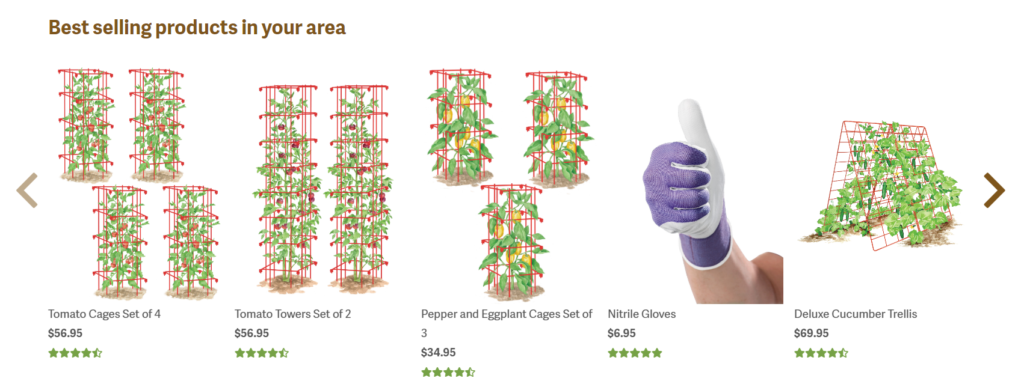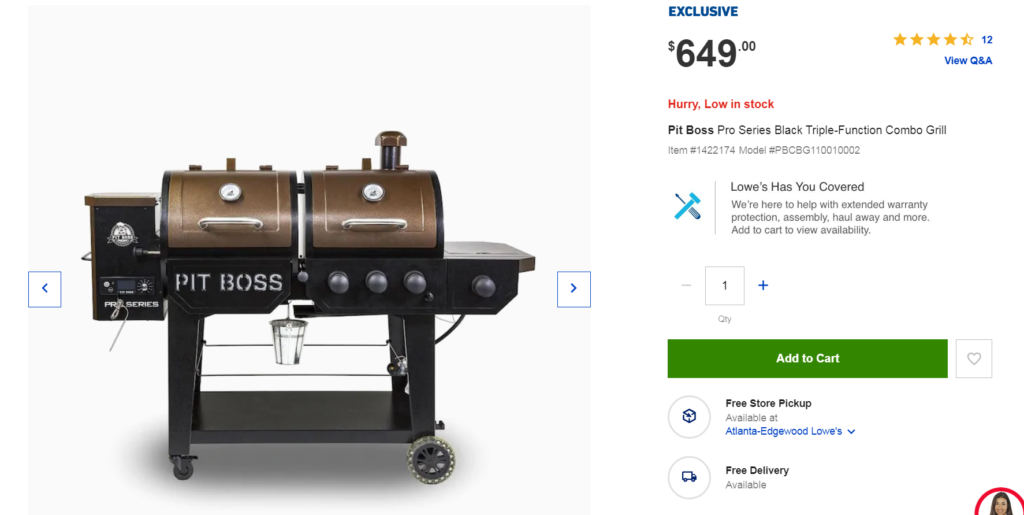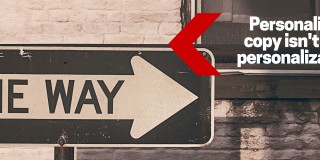At some point, personalization may seem like a good next step to level up CRO efforts. But companies—if and when personalization does make sense—often try to use algorithms immediately, relying on AI and machine learning to create personalized experiences.
Many also get started with marketing tools that have data collection and AI built-in, resulting in a fragmented experience for the customer and suboptimal results for the company.
Rhett Norton advises caution: “The tool-first strategy is one of the worst because it puts your strategy in the backseat while your tool drives you off a cliff.”
Indeed, personalization isn’t just about data and algorithms. To do it properly, you need:
- Processes in place;
- Enough people to create relevant content for all variants;
- Systems that can serve the content, etc.
It requires a big investment to operationalize full-on personalization. And the larger the investment, the larger the risk.
Therefore, it makes no sense to start with all-out personalization (unless you’re desperately bored and have money to burn). As with A/B testing, you can start small and gradually build a more comprehensive program if your initial forays pan out.
Of course, if you show early results, it’s easier to win resources that can scale and automate your personalization. The incremental steps toward that level of personalization are similar to those for CRO: research, hypothesis, create test, run test, evaluate.
The focus of this article is to show, using a hypothetical example, a pragmatic way to move toward personalization. Doing so highlights the various stages of the process and what to expect in each; it also simplifies some aspects.
I’ve used this same approach at multiple ecommerce companies. It all starts with something you’re familiar with—segmentation.
Table of contents
Starting with segmentation
Let’s take a fictitious company, “The Garden Company,” which sells garden equipment ranging from a shovel to a lounge set. They have a large product portfolio and spend a lot of money on marketing. They’re also continuously optimizing their website with A/B tests.
For them, personalization may be a logical next step. Many things can be personalized, like which channels to target for which users, in what order, in what timeframe, with what content, which products, etc.
As Conductrics CEO Matt Gershoff writes:
The question is not can I personalize an experience—at this point there are a thousand different tools and ways to do so. So the simple act of creating an experience is not the goal, the goal is to do so in the way that generates the greatest ROI for my organization.
The question needs to be, “How do I discover the most valuable way to change the experience?”
In this hypothetical case, we’ll tackle a common user experience problem on big ecommerce sites—the findability of products.
Do the research to identify and prioritize potential segments
Just like when creating an A/B test, research identifies potentially valuable segments.
If you’re already doing CRO, a lot of consumer research and knowledge is already available. Everyone from product experts, buying departments, and analysts have data-backed hypotheses about the customer base.
Existing research plus internal conversations alone can help identify possible attributes for segmentation. The Garden Company, for example, has the following hypotheses:
- Our customers could be classified as “garden loungers” or “active gardening hobbyists.”
- Some customers are more discount sensitive than others.
- Some customers prefer high-end brands and are willing to pay more for them.

Looking for broad, data-backed divisions within your audience is different than immediately picking and personalizing to a single segment. Norton has seen the latter approach fail often:
The segment-first personalization method is dangerous because it limits the sample size too soon. Good personalization starts as broadly as possible, then hones in where value is discovered.
You should also prioritize which segments to target based on expected value and ease of implementation, something Ismaël Sow recommends:
Build a personalization roadmap where you list all segments and associated experiences you want to assign to them.
Then, give a score to each item on your list based on the size of the segment, the resources and time needed to build the relevant experience, and the magnitude of the uplift you anticipate from it.
Start with the ones that have the biggest impact and the lowest effort required.

Analyze the potential segments based on a little data
Check your proposed segments against some data. There’s no need for a full 360-view of the customer (which, let’s be honest, doesn’t really exist) to start this analysis. Customers’ purchase data and some analytics data should be sufficient.
The Garden Company uses their order data to do a cluster analysis on purchased product categories for the loungers vs. hobbyists segments. Surprisingly, it doesn’t show two clusters but three: loungers, decorative gardeners, and food gardeners.
Prepare to be surprised often, notes Andrew Anderson:
One of the things that takes the longest time to understand is that the things that you need to target on are never the things you think you need to target on. I have worked with over 100 different groups trying to do “personalization,” and I have not once had the initial targeting idea prove to even be valuable let alone the best option.
A cluster analysis on brands shows that, indeed, certain customers prefer high-end brands or cheaper options. To determine the discount segments, a percentage discount can be picked for the segments, or a set of bins could be used.
Hypothesized segments that don’t pan out in the data should be ignored.
Based on these results, The Garden Company will first test the loungers vs. decorative vs. food segment. To test this segment, users are classified based on their buying behavior and the products they view online. With this classification, an A/B test can be set up for one of the segments.
Create a test
To set up a segmentation test, choose a channel. The easiest option depends on the technology and tools in place. If your website is heavily cached, you may need a lot of developer help to deal with this—not ideal for a proof-of-concept.
But if the website runs a good merchandising tool (e.g., Bloomreach, Algolia, Magento) that allows for custom segments, it might be fairly easy. Email is often a good channel to start with as it does not suffer from caching issues, users logging out, and other events that make test analysis difficult.
At The Garden Company, the test is run on email, and a segmentation attribute is added to the classified users in their email platform. As there are limited resources for content creation, the email team is asked to create one additional email beyond their default newsletter: an email for loungers.
So, in the first test, 50% of loungers get the default newsletter and 50% the targeted version. It’s important to show the control to the target segment and the variation to the general audience.
We want to see if the personalized experience is indeed better for the audience it was built for. The only way to prove that is to show that experience to other audiences, and to show the intended audience other experiences.
In our hypothetical case, the targeted version yields an impressive 15% more revenue for the loungers. With these numbers, the email team is immediately willing to test the other segments as well—and make more people available to create these emails.
With the additional resources, all segments are tested through emails, where three segments and three emails are fully combined to create a 3×3 test in the email. This way, The Garden Company gets a general sense of how the segments impact their email results.
Moving forward
After having learned which segments work in the chosen channel, there are three ways to move forward:
- Repeat the initial test in other channels. This is often the easiest step when the same users can be identified in another channel.
- Combine segments. Take this step when the content creators have extra time available to create more relevant content.
- Add trigger behavior. This is fairly easy when properly defined product attributes are available in the email platform.
All of these steps can add value, and the order in which these are performed isn’t fixed. Again, go with what’s easiest.
1. Repeat the initial test in other channels.
As always, when a test has shown impact, take what works and scale up. Use the segments and simply test them in other channels. For example, The Garden Company could use the same classification and apply it to display advertising to learn whether it works there as well.
Another great option is to sort the product display on the website based on segments. As the emails have shown a good impact, it may suddenly be easier to get a group of developers to help build this feature.

2. Combine segments
When multiple segments have shown to work, a combination could make the experience for the customer more personal. Combinations of product category segments and brand segments could work together (e.g., loungers with a preference for high-end brands).
Combining segments does add complexity when it comes to creating content and managing tests. The number of variants grows fast. Just testing the brand and product category segments results in six user segments and six different emails.
Gershoff explains the challenge:
While targeting can be incredibly valuable, many in the industry haven’t fully grasped that targeting always leads to greater organizational complexity, and that greater complexity means greater costs. Complexity is the flipside to targeting.
At some point, having a scalable content hub or digital asset management becomes necessary to scale content creation together with personalization. When content can be easily reused and combined in multiple templates, content creation for personalisation becomes feasible.

Many tools support it (e.g., Bynder, Nuxeo), but the tool is not the solution—it’s about the process of tagging and reusing content. This might require changing the way content is created by content teams.
All in all, segmentation starts to require more resources to set up and manage tests; you’ll need results to win those resources.
3. Add trigger behavior.
Based on what you learned from segmentation, it might be worthwhile to take recent behavioral data into account. Loungers who start looking at a new BBQ should be targeted based on that product instead of the general lounger communication, which might be based on a product category.

With the combination of segments, reasonable assumptions can be made about what online browsing behavior is meaningful and what isn’t. If a lounger looks at four BBQs, of which two are premium brands and two cheaper brands, what should be the primary target?
It depends on the segment the user has for brands. If it is a premium brand user, target the user with premium brand BBQs and accessories. This targeting can, of course, be applied through multiple channels, as described earlier.
Making it more personal
Combining segments and applying these to multiple channels consistently with the addition of behavioral triggers is already pretty impressive. It might qualify as the point at which segmentation crosses over into personalization.
It can also be taken to the next level with truly personalized algorithms.
Start with adding personalized recommendations
With the segments as a base, you can set up a recommendation algorithm. At The Garden Company, they decide to add a set of recommended products based on what other people viewed within the same segment.

So, the decorative gardeners get a couple of more detailed recommendations in their segmented email. This small adjustment within a segment makes it easy to determine the additional value of these algorithms without the risk of weird recommendations—you know that the products are for a specific (and relevant) segment.
With each test, The Garden Company further improves the algorithms behind the recommendation and applies them to other channels and segments.
Start with orchestration
As the channels are now showing consistent content, you can begin to test which channel works best for each user. This can be done by reaching users who normally respond well to banners with retargeting banners (instead of, say, retargeting emails).
It’s an additional form of segmentation, applied at another level. This can be taken a step further by determining how long to wait before sending the follow-up email after showing a retargeting ad.
Going from segmentation to personalization
Soon, all the segments, triggers, channels, and orchestration become too complex to manage. Looking at the examples of The Garden Company, there might be three category segments, two brand segments, and perhaps five segments of discount sensitivity—30 segment combinations.
Combined with all the channel segments and orchestration steps, the set of rules is becoming quite complex. The advantage is that—with all the tests—a lot of data is generated (e.g., which user responds to what content, channel, order, and timeframe).
Further, as content is segmented, many marketing efforts are classified in one or more of the segments (e.g., decorative garden, premium brand, discount email user). The combination of all this data and classifications for content makes it ideal for machine learning.
Conclusion
The last stage—AI-driven personalization— isn’t one that could have been reached without taking the preceding steps.
What applies to each step also applies to machine learning: Start small and keep learning what works. Machine Learning is just another tool to keep adding impact to all the segments and learnings picked up along the way.
Read more about personalization strategy—and cautionary tales—here:
- 6 Proven Cairns on the Path to Personalization (and 5 Pitfalls to Avoid)
- Running Before You Walk: What You Need to Know About Personalization
- Why Content Personalization Is Not Web Personalization (and What to Do About It)
- Why Sites Are Getting Personalization Wrong (and How to Fix It)
- Personalization: How to Build a Revenue Boosting Program from Scratch
- How to Use Personalized Content and Behavioral Targeting For Improved Conversions





